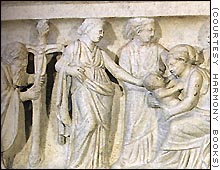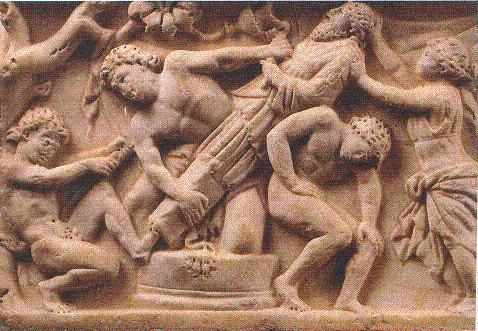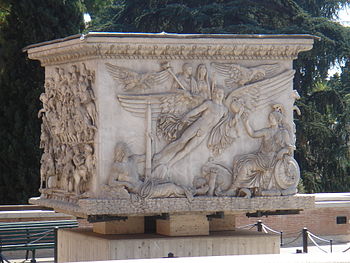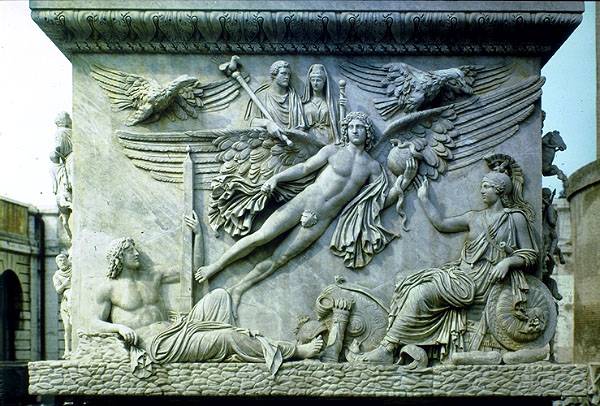
 |
Freethought & Rationalism ArchiveThe archives are read only. |
|
|
#71 | |
|
Regular Member
Join Date: Dec 2011
Location: The only Carribean port not in the Tropics.
Posts: 359
|
Continuing the train of thought of the vineyards...
Pliny actually called the horizontal bars of a vine fence or a vine trellis a patubulum: which was also a door bar and a horizontal beam on which to suspend criminals! Quote:
http://penelope.uchicago.edu/Thayer/...Elder/17*.html http://penelope.uchicago.edu/Thayer/...ultura/A*.html http://penelope.uchicago.edu/Thayer/...ultura/C*.html |
|
|
|
|
|
#72 | |||
|
Veteran Member
Join Date: Apr 2003
Location: Australia
Posts: 5,714
|
Quote:
 I love the mental image from that. "Forgive them, Simba, for they know not what they do!" I love the mental image from that. "Forgive them, Simba, for they know not what they do!"Quote:
From memory, Freke & Gandy used this analogy to show that Dionysus (god of wine) was portrayed as crucified on a cross. You might want to check into that. |
|||
|
|
|
|
#73 | |||
|
Regular Member
Join Date: Dec 2011
Location: The only Carribean port not in the Tropics.
Posts: 359
|
Quote:
 Quote:
    I also found a Dionysian antecedent of the Triumphal Procession complete with donkey, here: ----> http://www.flickr.com/photos/pelegrino/6470638091/ I also found a Dionysian antecedent of the Triumphal Procession complete with donkey, here: ----> http://www.flickr.com/photos/pelegrino/6470638091/
|
|||
|
|
|
|
#74 | |
|
Regular Member
Join Date: Dec 2011
Location: The only Carribean port not in the Tropics.
Posts: 359
|
Going back to the deification of the Caesars with images and some kind of crosses for a bit:
The first (and perhaps only*) Caesar who was deified in such a manner was Gaius Julius Caesar and it was done at his funeral, 17 March 44 BCE. Francesco Carotta (yes, that one!) :redface: was the first to figure this out, by working out contradictions in the accounts of Cassius Dio Roman History 44.35.4, Nicolaus Damascenus Bios Kaisaros FGrH 130 (26), Appian Belle Civile 2.146-147, and Suetonius Divus Iulius 82.3 & 84.1. He has concluded that the wax image of Julius Caesar was installed on a cruciform tropaeum, covered with his bloodstained toga, while his actual body was laying in a bier modelled after the Temple of Venus Genetrix. The History Channel a few years back picked up on this and showed one possible representation of this in their program Death Masks. The discussion of the death and wax image of Julius Caesar on a cruciform tropaeum runs from 5:02 to 9:32 and shows a representation of it bound to a martyr's stake, which is shown with a crossarm. Now how would this tie-in to Predecessors and Antecedents to the new Testament Jesus? Well, Dionysius can be considered an antecedent (remember the wedding at Cana where he turns water into wine) (Also note the images of the 'crucifixion' of Dionysius in the post above). And those aren't the only similarities: http://www.religioustolerance.org/chr_jcpa2.htm  http://en.wikipedia.org/wiki/Flamen_Divi_Iulii has some information: http://en.wikipedia.org/wiki/Flamen_Divi_Iulii has some information:Quote:
* Even though I still maintain Justin Martyr and Tertullian claim otherwise. I suppose I'll have to pick apart the Greek and Latin texts. |
|
|
|
|
|
#75 | |
|
Regular Member
Join Date: Dec 2011
Location: The only Carribean port not in the Tropics.
Posts: 359
|
And the hypothesis that a wax image of Julius Caesar was displayed on a cruciform tropaeum is gaining academic acceptance:
Quote:
At 2:49 through 3:04 you see the wax image of Julius Caesar's mutilated body on a "rotating pole" and the video shows the pole equipped with a crossarm. Also http://www.youtube.com/watch?v=NliEGCnlSwM (Nothing on Caesar in this one, though.) |
|
|
|
|
|
#76 | ||
|
Regular Member
Join Date: Dec 2011
Location: The only Carribean port not in the Tropics.
Posts: 359
|
Since these early Fathers said that a man in his natural upright position and a bird in midflight with wings outstretched both form the shape of a cross...
Quote:
Quote:
 Source: Wikipedia. Note that in the right light even the lines of the chest and abdomen of the rising god forms some sort of cross!  Source: faculty.catawba.edu Now after they form the first image out of what according to Tertullian is white clay (argilla) over a cruciform understructure, and when they display it as a 'god' at the deification of the deceased Emperor, it will be in the form of a cross. Now they are going to have to elevate it so the crowd can see it, and to elevate it they are going to have to mount it on something. They can't just have it float in mid-air with no means of support for it's not made out of helium and besides they didn't have balloons back then. |
||
|
|
|
|
#77 | |
|
Veteran Member
Join Date: Apr 2003
Location: Australia
Posts: 5,714
|
Quote:
A winged genius (sometimes identified as Aion, Eternity) carries Antoninus and his wife Faustina to Heaven. The Emperor holds a sceptre crowned with an eagle, whilst eagles also fly upwards with them.So: (1) The winged person is a spirit carrying Antoninus Pius and Faustine to Heaven (pictured just above the winged person). The Emperor is holding a sceptre. (2) The emperor is not portrayed in anything like a cross-like shape. |
|
|
|
|
|
#78 | |
|
Contributor
Join Date: Feb 2006
Location: the fringe of the caribbean
Posts: 18,988
|
Quote:
There is NO need for Jesus to have been a real man for people to have Believe he existed. Jesus could have been a Winged person or a Winged Spirit or the Son of God and people of antiquity would STILL BELIEVE Jesus was a figure of history. We know that the Romans and Greeks did BELIEVE in MANY MANY Myth Gods and that the religion based on Jesus Christ was COMPETING against them. It is NOT logical at all that a NEW Religion would present a Jesus Christ who did NOTHING miraculous at all during his life to COMPETE against ZEUS/JUPITER as we see in the supposed early Pauline writings. Remarkable, the Pauline writer was supposedly in Rome and Corinth where people and the Roman Government worshiped Myth Gods but the Pauline Jesus did NOTHING to match the Roman/Greek Gods. It was the author of gMark that presented a Son of God story that OUT-PERFORMED or Matched the actions of the Roman/Greek Myth Gods in their Myth Fables. The Pauline NO Miracle Jesus would NOT stand a chance in Rome and Corinth Only the Markan MIRACLE Jesus would make sense in the Roman Empire as a COMPETITOR of their Myth Fables. |
|
|
|
|
|
#79 | ||
|
Regular Member
Join Date: Dec 2011
Location: The only Carribean port not in the Tropics.
Posts: 359
|
Quote:
Yet this is still another example that Xtians would point to that the Roman Religion was "all cross!" Now in On Prayer 29:4 Tertullian (assuming he wrote it) said that the birds when they flew up into the sky they extended their wings in the sign of a cross. Notice at the base of the column that Aion is flanked by two birds, eagles, showing the same distortion. And HE with his wings forms the sign of a cross. So now we have Emperor Antoninus Pius and his wife Faustina being borne aloft to Heaven ON A CROSS. And why not? Romans didn't just have execution crosses (crux, σταυρός) but they also had votive / victory crosses (tropaeum, τρόπαιον). |
||
|
|
| Thread Tools | Search this Thread |
|